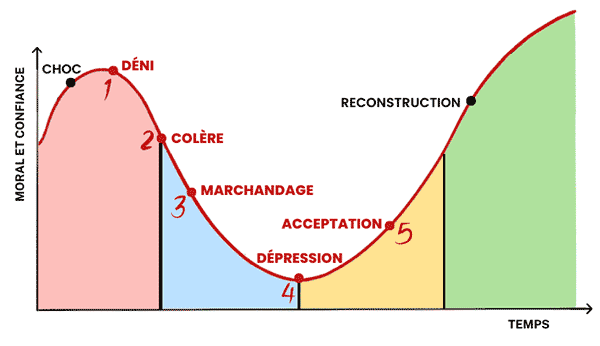The Kübler-Ross 5 Stages of Change Theory is also known as the Five Stages of Grief Model. It appeared in 1969 in the book On Death and Dying (translated under the title The last moments of life) of a Swiss-American psychiatrist and psychologist, Elisabeth Kübler-Ross (1926-2004).
The Grief Curve
This model, originally called (1969) the “grief curve”, describes the different emotional phases that individuals can go through when they have to face a major shock. It results, not from clinical studies, but from more than 200 interviews carried out with terminally ill patients.
The psychiatrist was studying the stages that a person must go through who has just learned that they suffer from an incurable illness. The aim was to collect information from these patients relating to their perception of their own death.
Although not consensual, the theory of the 5 stages of change also applies to situations of major change or loss, such as the loss of a job, the end of a relationship or any other significant event that disrupts emotional balance. of a person.
It is now widely used in companies, because it allows employees to better prepare for the various changes that may affect them in the event of a major transformation (merger, takeover, filing for bankruptcy, relocation, etc.).
What are the 5 stages of change?
The five stages of change are:
1. Denial
It is the first reaction to a difficult situation. We refuse to believe or accept the reality of what is happening. We are in a state of shock, disbelief, and we have difficulty understanding what is happening.

2. Anger
After denial, we feel anger towards the situation, the other people involved or even towards ourselves. You can express your anger or keep it to yourself, but it’s part of the emotional healing process.
3. Bargaining
At this point, we try to negotiate or find ways to go back. We look for compromises or solutions to escape the reality of the situation. We try to find a way out of the emotional pain.
4. Depression
When attempts at negotiation fail, we fall into the depression phase. We feel a deep sadness, a feeling of loss and despair in the face of reality.
5. Acceptance
Eventually, we reach a phase of acceptance of reality and we begin to adapt to the new situation. This does not mean that all negative emotions disappear, but rather that we find resources to build a new emotional balance and deal with the situation in a more constructive way.
A practical model, not a universal theory!
Not everyone necessarily goes through all the stages in the same order or with the same intensity. Some may spend more time in one stage than another, or even return to a previous stage.
Moreover, in 2017, researchers warned health professionals that this five-phase model, which was intended to be purely descriptive, has become, wrongly, “prescriptive”, that is to say, it is referred to too much. often as the norm in the process of grieving or accepting the illness. A choice which, they write, can harm certain people.
We must therefore use the 5 stages of change curve as a practical tool, not a scientific truth. But this model remains very useful for simply explaining the emotional reactions that can occur in the face of radical change, a feeling of loss or abandonment.
Of course, this is not a universal theory: you must keep in mind that each person is unique and reacts differently to a given situation.















